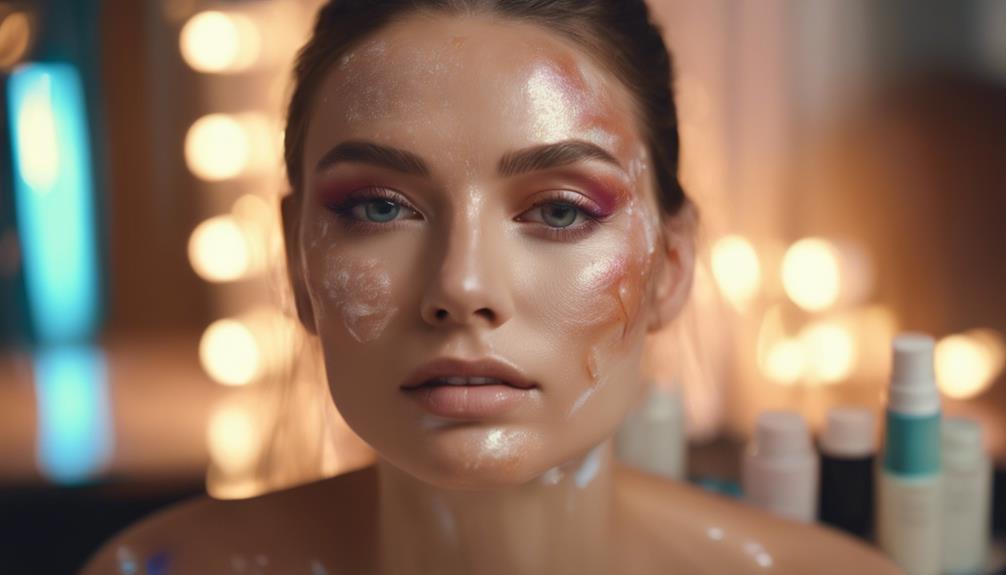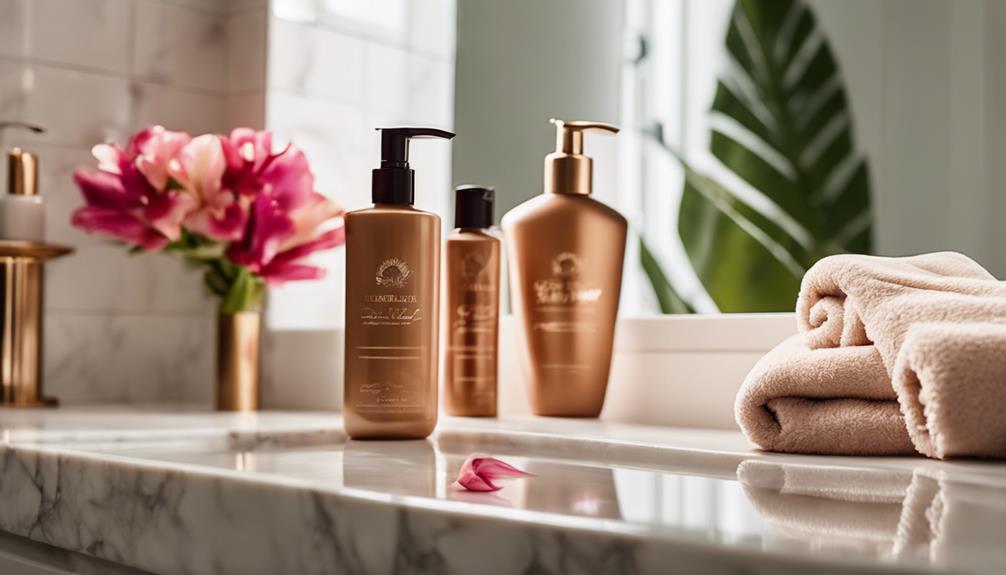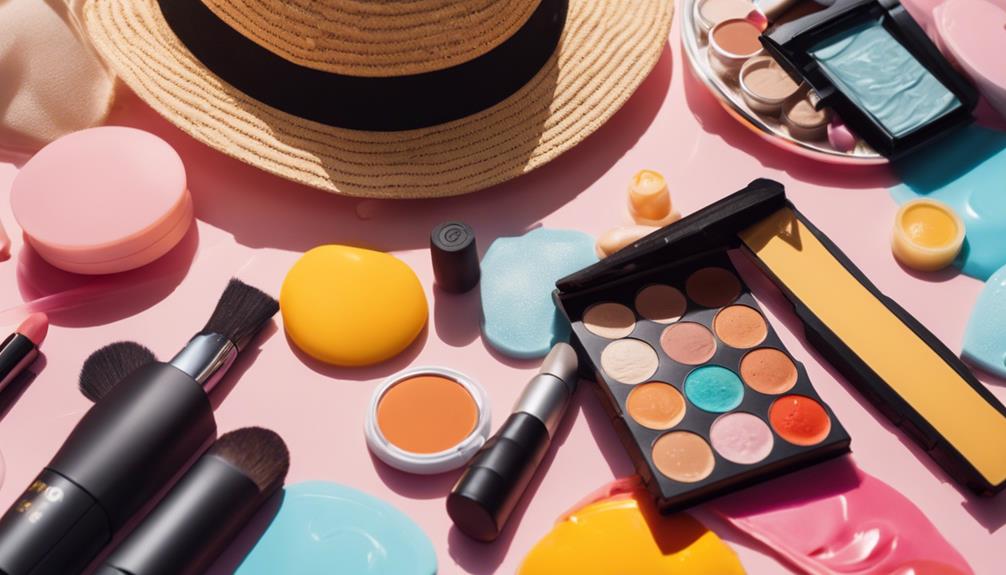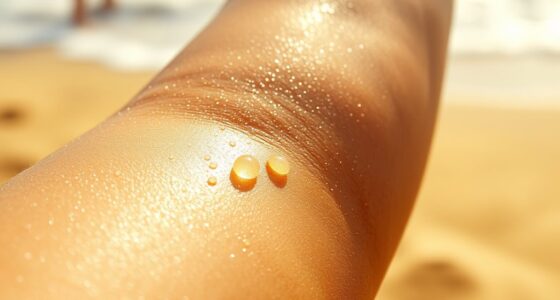If you notice your skin absorbing makeup, it's essential to take action. Start by prepping your skin with a good moisturizer to create a smooth base; this locks in hydration and prevents pilling. Using a silicone-based primer helps keep makeup on top rather than allowing it to soak in. Opt for lightweight, non-comedogenic foundations to avoid clogging pores. A quality setting spray can seal everything in place and enhance longevity. Regular exfoliation also maintains smooth texture, giving you an even application. By following these tips, your skin can stop 'eating' your makeup, and you can achieve a flawless look every time.
Key Takeaways
- Ensure your skin is well-moisturized and primed to create a smooth base that prevents makeup absorption.
- Use silicone-based primers to form a barrier that keeps makeup from sinking into the skin.
- Opt for lightweight, non-comedogenic foundations to avoid clogging pores and allow skin to breathe.
- Allow each skincare layer to dry completely before applying makeup to prevent pilling and ensure compatibility.
The Truth About Makeup Absorption
Makeup absorption happens when your skin isn't properly prepped, leading to uneven application and possible irritation. If your skin's dehydrated or compromised, it can absorb certain makeup ingredients, altering their performance. That's why a solid skin care routine is crucial.
Start with a good moisturizer. A well-formulated moisturizer works wonders by creating a smooth canvas, locking in hydration, and minimizing makeup absorption. You want to guarantee your skin is adequately hydrated before applying any makeup.
Make sure to allow each layer of skin care to dry completely before moving on to makeup application. This helps prevent issues like pilling, especially with silicone-based products.
Once you've got your makeup on, don't forget the setting spray. It acts as a protective layer, sealing your makeup and reducing the likelihood of absorption throughout the day.
Plus, it enhances makeup longevity and prevents that cakey look. By prepping your skin properly with a moisturizer and finishing with a setting spray, you can considerably improve how your makeup looks and feels, preventing your skin from 'eating' your products.
Risks of Makeup Consumption

Improper makeup application and absorption can expose your skin to harmful chemicals and toxins, raising significant health concerns over time. When your skin absorbs these substances, it can disrupt hormone levels and lead to skin irritation. Knowing the risks associated with various makeup products is essential for maintaining healthy skin cells.
Here's a quick overview of some common risks associated with makeup consumption:
| Risk | Description | Prevention |
|---|---|---|
| Hormonal Disruption | Chemicals can interfere with hormonal balance. | Choose natural or organic makeup products. |
| Skin Irritation | Irritants may cause redness and sensitivity. | Patch test new products before full use. |
| Acne Breakouts | Pore-clogging ingredients can lead to blemishes. | Follow a proper skincare routine. |
| Allergic Reactions | Allergens in makeup can cause contact dermatitis. | Opt for hypoallergenic makeup options. |
Symptoms of Makeup Overindulgence

When you overindulge in makeup, your skin may show symptoms like increased oiliness and uneven texture, signaling that it's struggling to breathe. This excessive layering can suffocate the skin and disrupt its natural barrier. You might notice that your complexion appears dull and dehydrated, hinting that your skincare products aren't providing enough hydration to counteract the heavy makeup.
If you're experiencing pilling, where your makeup balls up, it's a sign that the products you're using aren't compatible with your skincare routine. Make sure to check the ingredients in your makeup, as those high in silicones or oils can lead to clogged pores and exacerbate skin issues like acne and blackheads.
Additionally, keep an eye out for breakouts, which can indicate that your skin is reacting negatively to comedogenic ingredients in your makeup. If you notice these symptoms, it's essential to reassess not just your makeup choices, but also how you're layering products.
The health of your skin depends on maintaining a balance between makeup and effective skincare products. Remember, your skin deserves to breathe!
Innovative Makeup Formulations

Explore how innovative makeup formulations are transforming your beauty routine by incorporating skin-loving ingredients that hydrate and nourish while providing effective coverage.
With the inclusion of hyaluronic acid, these products boost your skin's moisture levels, creating a plump and radiant appearance. You'll find that many brands have developed breathable formulas that let your skin maintain its natural moisture balance, preventing that heavy, cakey feel.
Recent advancements in makeup technology have introduced lightweight, silicone-based products that minimize pilling and enhance smooth application. Some innovative makeup formulations even integrate chemical exfoliants, promoting skin renewal and ensuring a flawless finish. This means your makeup not only looks good but also contributes to a healthier complexion over time.
Additionally, many products now offer built-in antioxidants and SPF protection, shielding your skin from environmental stressors while you wear them. Setting sprays and powders have evolved, too, providing hydration and a natural finish, so your makeup stays put without suffocating your skin.
Embrace these innovative makeup formulations to achieve a stunning look that cares for your skin simultaneously.
Tips to Prevent Makeup Absorption

To keep your makeup looking fresh all day, start with a well-moisturized and primed skin base that fully absorbs your skincare products before applying any makeup. This helps prevent pilling and enhances the longevity of your look.
Consider using silicone-based primers; they create a barrier that stops makeup from sinking into your skin while providing a smooth canvas.
When selecting your foundation, opt for lightweight, non-comedogenic formulas. These foundations sit on top of your skin rather than being absorbed, giving you a natural finish without sacrificing hydration.
After applying your makeup, don't skip the setting spray. It adds an extra protective layer that locks your makeup in place and minimizes absorption throughout the day, ensuring you stay fresh.
Lastly, regular exfoliation is key. Maintaining a smooth skin texture prevents rough patches that can lead to uneven makeup application and increased absorption.
Frequently Asked Questions
How Do I Stop My Skin From Absorbing Makeup?
To stop your skin from absorbing makeup, establish a good skincare routine with a lightweight moisturizer, apply a primer, choose oil-free foundations, and use setting sprays. Regular exfoliation helps too, just don't overdo it!
Why Is My Face Eating My Makeup?
Your face might be "eating" your makeup due to hydration issues or improper layering. Try adjusting your skincare routine, using compatible products, and ensuring your skin's well-hydrated for a smoother makeup application.
How Do You Make Makeup Not Ruin Your Skin?
Did you know that 60% of women experience skin irritation from makeup? To prevent this, you need a solid skincare routine, choose non-comedogenic products, and always set your makeup to maintain healthy, happy skin.
Is It Healthier to Not Wear Makeup?
Yes, it's healthier to skip makeup sometimes. Your skin can breathe and heal, reducing irritation and clogged pores. Embracing a no-makeup routine can improve your skin's texture and enhance your natural beauty.
Can Wearing Makeup with SPF Impact the Way Your Skin Absorbs and Eats Your Makeup?
Wearing makeup with SPF effectiveness can actually help protect your skin from harmful UV rays while also creating a barrier between environmental factors and your skin. This can impact the way your skin absorbs and eats your makeup, as the SPF can prevent premature aging and damage caused by the sun.
Conclusion
In the dance between your skin and makeup, you hold the lead. By choosing innovative formulations and following simple tips, you can protect your skin from unwanted consumption.
Imagine a vibrant canvas, free from the shadows of irritation and breakouts, where your beauty shines through with confidence. Embrace this journey, and let your makeup enhance rather than invade.
With care and awareness, you'll keep your skin happy, allowing your true radiance to glow like sunlight breaking through the clouds.









